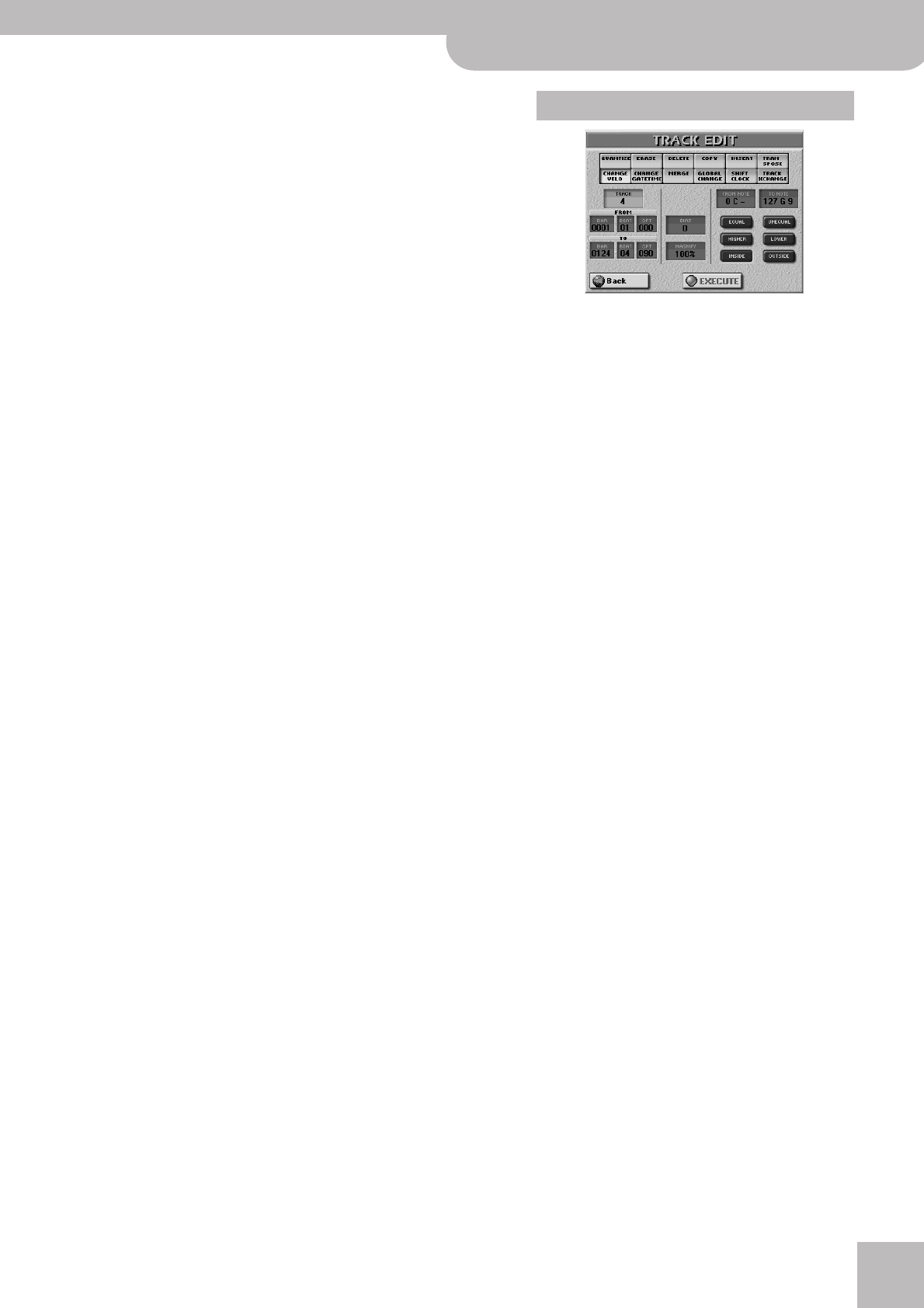
Editing 16-track songs
E-80 Music Workstation
r
185
Warning: “0” represents the lowest note the MIDI standard
(and the 16-track sequencer) can handle, while “127” is the
highest note. If you select “127” for note number “74 (D5)”,
for example, the resulting note number would be “201”,
which is impossible. Therefore, the sequencer will subtract
“12” from “201” until the result is less than or equal to
“127” – and therefore use the value “117” in our example.
This happens to all notes that would otherwise lie below
“0” or above “127”.
Note: Be careful when applying TRANSPOSE to a drum track
(track 10 or any other track that uses a Drum Set). This results
in a dramatic change of your rhythm section (with a triangle
playing the kick notes, for example).
■FROM NOTE (0 C-~127 G9)
This parameter allows you to set the note (or lower limit of
the note range) to be modified within the specified FROM/
TO time range.
It is not displayed when you select EQUAL, UNEQUAL,
HIGHER or LOWER. See also “Fine-tuning the setting range”
on p. 182 for details about the six button icons.
■TO NOTE (0 C-~127 G9)
This parameter allows you to set the upper limit of the note
range to be modified within the specified FROM/TO time
range.
■EXECUTE
Press this field to confirm your settings and edit the data.
The CHANGE VELO function allows you to modify the
dynamics (called “velocity”) of a track or excerpt.
Increasing the velocity values means that the notes
in question will be louder and brighter than before,
while reducing the velocity values means the oppo-
site. Use this function when you are happy with the
timing of the notes but would like the sound to be
brighter/louder or rounder/softer. You can decide to
add/subtract a fixed velocity value (“BIAS”) or to
change them proportionally (“MAGNIFY”).
■TRACK (ALL 1~16)
Allows you to select the track you wish to edit. You can
also select “ALL” here, in which case the operation applies
to all tracks.
■FROM
● BAR (1~[last measure of the track or song])—Refers to
the first measure to be edited. By default, the FROM
value is set to the beginning of the selected track(s).
● BEAT (1~[number of beats per bar])—Specifies the
beat position. The number of available beats depends on
the time signature in the selected area.
● CPT (1~119)—Refers to the starting CPT position. “CPT”
is short for “Clock Pulse Time”, the smallest unit used by
the E-80. (There are 120 CPTs to every beat of a 4/4 bar.)
Change this setting only if your edit operation should
start after the selected beat.
■TO
By default, the TO position is set to the last event of the
selected track (or the last event of the longest track when
you select “ALL”).
● BAR (1~[last measure of the track or song])—This is
where you specify the bar position of the last measure to
be edited.
● BEAT (1~[number of beats per bar])—Specifies the
beat position. The number of available beats depends on
the time signature in the selected area.
● CPT (1~119)—Refers to the last clock that should be
affected by the edit operation. Change this setting only
if your edit operation should not end exactly on the
selected beat.
■BIAS (–99~99)
The BIAS parameter allows you to specify by how much the
velocity values should change. Select a positive value to
increase the velocity (the value is added to the velocity
value of the affected notes) or a negative value to decrease
the velocity values (that value is subtracted). Select “0” if
you prefer to work with the MAGNIFY parameter (see
below).
CHANGE VELO
